Sea Pictures - Alive and Well
by Charles A. Hooey
When I first heard Elgar's Sea Pictures,
I instantly fell in love with the music and found it firing
fresh interest in
the composer. Why this sudden and intense fascination for a
mere twenty-three minutes of music? It had to do with my location,
for on this great Canadian prairie the sound of ocean waves
lapping
on a shore lies strictly in the imagination. When the wind
blows wheat fields that extend as far as the eye can see, one
can easily
picture undulating seas. Is it any wonder that in World War
II prairie-born lads were quick to don Navy blue?
That initial discovery came thanks to a recording provided
by a friend in New Zealand. The singer was Janet Baker but
it was not her famous 1965 commercial recording with Barbirolli
but part of a concert she gave in New Zealand three years later.
The youthful Janet was inspired and in sumptuous voice and
with both conductor Juan Martinucci and the New Zealand Symphony
in
perfect accord they stir the blood and score the memory.
More than a century has elapsed since Elgar penned his evocative
music, setting the songs down thus: Sea Slumber song (No.
1), In haven (No. 2), Sabbath Morning at Sea (No.
3), Where corals lie (No. 4) and The swimmer (No.
5). Actually the cycle was begun in 1897 when the composer
set to music a song written by his wife Alice and had it published
as The lute song. Then, after amending the text to strengthen
the sea references, Alice produced In haven. Although
one article cannot hope to reveal the entire performance history
of Sea Pictures, the aim is simply to describe a tiny
portion to validate the widespread importance and vitality
of this music.
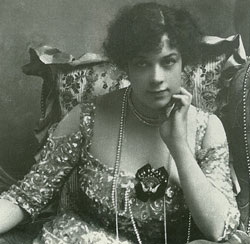 Sea
Pictures was written with Clara Butt (pictured) in
mind, and if we are to believe her creative friend and biographer
Winifred Ponder, it happened thus: After returning from Paris
and living
at Hyde Park Mansions, Clara one day found her companion Madame
Snella at the door to say someone wanted to see her about music
he had written. Clara, contentedly splashing in her bath, called
out she wasn't coming to see anyone. After delivering this
message, Madame Snella returned, evidently impressed, to say, “Oh,
`Baby' dear, do see him! He's such a nice man, and he's got
a whole cycle of songs to show you!” But Clara, not
about to abandon a perfectly good hot bath for all the nice
men in
London, retorted, “I don't care if it's a bicycle!
If he wants to see me he must call another day!’” The “nice
man” was Edward Elgar, then quite unknown and the next
day he did return and was admitted. As soon as he had played
his songs Clara knew she had found music that could have emerged
from her own soul.
Sea
Pictures was written with Clara Butt (pictured) in
mind, and if we are to believe her creative friend and biographer
Winifred Ponder, it happened thus: After returning from Paris
and living
at Hyde Park Mansions, Clara one day found her companion Madame
Snella at the door to say someone wanted to see her about music
he had written. Clara, contentedly splashing in her bath, called
out she wasn't coming to see anyone. After delivering this
message, Madame Snella returned, evidently impressed, to say, “Oh,
`Baby' dear, do see him! He's such a nice man, and he's got
a whole cycle of songs to show you!” But Clara, not
about to abandon a perfectly good hot bath for all the nice
men in
London, retorted, “I don't care if it's a bicycle!
If he wants to see me he must call another day!’” The “nice
man” was Edward Elgar, then quite unknown and the next
day he did return and was admitted. As soon as he had played
his songs Clara knew she had found music that could have emerged
from her own soul.
Clara went on to introduce the cycle at the Norwich Festival
on 5 October 1899, stepping on stage garbed in a gown that
glistened with sequins like a mermaid. She and the music were
instant hits.
This plus its brevity made Sea Pictures appeal to concert
organizers, as short bursts of brilliant music by different
composers were all the rage at the time. Thus, two, three or
four of Elgar's
sea songs became frequent programme elements. Clara became
much in demand to sing the music and within weeks of the première
she appeared at Balmoral Castle where Queen Victoria was eager
to hear this strapping mermaid sing of the sea.
The demands of oratorio in British Music had produced a host
of rich, low-voiced ladies who welcomed Elgar’s cycle,
the peerless Muriel Foster being one. While still a
student, she offered four of the songs on 15 March 1900 at
a St. James
Popular Concert, prompting composer C.V. Stanford to fire off
an excited evaluation and recommendation to Elgar. For the
time being he ignored the advice as Muriel continued to sing
the songs,
including a Gentlemen’s Concert under Dr. Hans Richter
on 15 October 1900 in the Free Trade Hall, Manchester. With Elgar
conducting, Clara Butt sang a few songs at Royal Albert Hall
on 12 December 1900 during tenor Edward Lloyd's farewell concert.
However, when the composer strode to the podium in St. George’s
Hall, Bradford on 16 February 1901, it was Muriel Foster who
joined him to sing four of his songs. The momentous collaboration
of Elgar and Muriel Foster had begun. But in mid-March 1904 when
Elgar was fêted at Covent Garden with a three-day festival
of his music, it was Clara Butt who sang Sea Pictures as
Richter conducted. The Hallé Chorus’s singing of
this and other Elgar music with its precision and full-blooded
tone gave London musical societies a lesson in how this music
should sound.
Two early interpreters were contralto Helen Valma who
first sang excerpts from Gerontius and then Sea Pictures at
an afternoon concert in Worcester on 9 May 1901. The other,
contralto Maud
Santley, introduced Sea Pictures in April 1904 to
music-lovers in Bournemouth. Early in 1908, Maud would have
her moment of musical notoriety when she was cast as Waltraute
in
the English Ring at Covent Garden. She sang in The
Valkyrie but couldn’t answer the bell on 1 February
for the scene with Brünnhilde in Twilight of the Gods so
her part was cut. Edna Thornton was asked to do a quick study
to sing Waltraute in the second performance on 8 February.
But redemption of a sort would come when Maud sang the sea
songs
that year on 22 November again in Bournemouth, when Dan Godfrey,
revered music director in the coastal town, finally was able
to welcome Sir Edward Elgar to the Winter Gardens to conduct
a special Saturday afternoon concert of his music. Included
were the Enigma Variations, the Meditation from The Light
of Life, his new Wand of Youth Suite No. 2, the Pomp
and Circumstance Marches Nos. 2 and 4 and last but not
least, Sea
Pictures sung by Miss Santley.
Muriel Foster sang Elgar's cycle countless times throughout
her illustrious career, even at a final concert on 31 January
1918
in Queen's Hall, London, to celebrate Major Mackenzie Rogan's “Fifty
Years in Army Music”. She sang Where corals lie and The
swimmer with Arthur Fagge conducting. Though wildly successful,
alas she did not record any of the songs; in fact, Muriel made
an attempt to record five ballads on 23 June 1904 but all were
rejected.
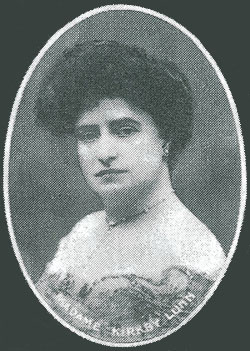 While
Muriel Foster avoided opera, Louise Kirkby Lunn (pictured)
embraced it, prowling the stages at Covent Garden and the Metropolitan
Opera in New York, often as a Wagnerian heroine. She sang Elgar's
music but left no recorded memento of Sea Pictures.
When she accepted the highly prized medal of the Royal Philharmonic
Society late in 1909, she did so during a concert when she
sang Sea
Pictures with Elgar conducting. Then at St. Andrew's Hall
in Glasgow on 4 December 1911, she offered In haven and Where
corals lie along with Mon coeur s'ouvre from Samson
et Dalila, Voi lo sapete and O lovely night by Landon
Ronald who conducted. They had recorded the latter song on
29 September; why, oh why did she not record Sea Pictures as
well?
While
Muriel Foster avoided opera, Louise Kirkby Lunn (pictured)
embraced it, prowling the stages at Covent Garden and the Metropolitan
Opera in New York, often as a Wagnerian heroine. She sang Elgar's
music but left no recorded memento of Sea Pictures.
When she accepted the highly prized medal of the Royal Philharmonic
Society late in 1909, she did so during a concert when she
sang Sea
Pictures with Elgar conducting. Then at St. Andrew's Hall
in Glasgow on 4 December 1911, she offered In haven and Where
corals lie along with Mon coeur s'ouvre from Samson
et Dalila, Voi lo sapete and O lovely night by Landon
Ronald who conducted. They had recorded the latter song on
29 September; why, oh why did she not record Sea Pictures as
well?
It took just over two years for Elgar’s magical creation
to cross the Atlantic, the bearer being Kirkby Lunn. She sang Sea
Pictures at the Auditorium in Chicago on 31 January 1903
with venerable Theodore Thomas at the helm. The following year
Muriel Foster sang In haven in Brooklyn on 18 March
1904 and three days later repeated in Hartford. Going on to
Chicago
she sang Sea Pictures on 30 April under Thomas’s
direction, and two weeks later on 14 May at the Biennial Festival
in Cincinnati again with Thomas, In haven, Where Corals Lie and The
Swimmer. Early in 1905 she made a third and final foray
to the U.S. where everyone in the Eastern states was frantic
to
hear her sing Sea Pictures.
When Kirkby Lunn returned to the U.S. in 1914, she evoked the
sea in New York as Mahler conducted. Then, on 2 April 1922,
Dame Clara Butt delivered her inimitable versions of Where Corals
Lie, In haven and The Swimmer at a Sunday night
concert for devotees of the Metropolitan Opera in New York.
Fellow artists
on hand were soprano Lenora Sparkes, tenor Orville Harrold
and bass Léon Rothier with Giuseppe Bamboschek conducting.
To round out the evening Clara added Divinités du Styx from Alceste to
the piano accompaniment of Grace Torrens. Has anyone sung Sea
Pictures on the Metropolitan Opera stage since?
Although Kirkby Lunn failed to record Sea Pictures she
left two other Elgar songs, The shepherd’s song and Like
to the damask rose recorded on 27 June 1921 although HMV
chose not to issue the former.
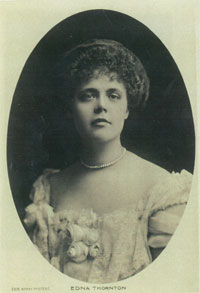 Edna Thornton (pictured), who followed Kirkby Lunn into opera,
spent a career interpreting a full range of mezzo roles, including
Delilah, Amneris and all the deep female characters in Wagner's Ring.
In 1905, she sang Sea Pictures under the composer's
direction and, although she did not record it, she did manage
a mountain
of other discs. On 16 July 1903, she made her first record,
Elgar’s Land
of Hope and Glory but it didn’t pass muster. Two more
versions followed, both making a release list. Edna took part
in a massive rendering of The Dream of Gerontius on
12 November 1904 with William Green, Frederic Austin and the
700
person strong Alexandra Palace Choir under Allen Gill. With
6000 seated and a further 2000 standing, it was the largest
audience
to that date to experience Elgar's oratorio.
Edna Thornton (pictured), who followed Kirkby Lunn into opera,
spent a career interpreting a full range of mezzo roles, including
Delilah, Amneris and all the deep female characters in Wagner's Ring.
In 1905, she sang Sea Pictures under the composer's
direction and, although she did not record it, she did manage
a mountain
of other discs. On 16 July 1903, she made her first record,
Elgar’s Land
of Hope and Glory but it didn’t pass muster. Two more
versions followed, both making a release list. Edna took part
in a massive rendering of The Dream of Gerontius on
12 November 1904 with William Green, Frederic Austin and the
700
person strong Alexandra Palace Choir under Allen Gill. With
6000 seated and a further 2000 standing, it was the largest
audience
to that date to experience Elgar's oratorio.
Marie Brema, the mezzo from Liverpool who on 3 October
1899 sang in the first performance of The Dream of Gerontius, likely
sang Sea Pictures on occasion. Born on 28 February 1856
as "Minnie Fehrmann”, the daughter of an American
mother and a German father from Bremen, Marie honoured Papa when
she assumed the name "Brema" on stage. Marie left no
records of this or any other music.
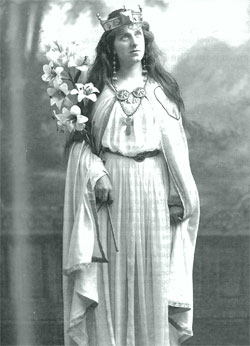 Elgar
in 1905 accepted an invitation from Admiral Lord Charles Beresford,
Commander of the British Fleet, to sail on H.M.
Surprise as his guest during a month-long cruise in the eastern
reaches
of the Mediterranean Sea. In Teraphia, Turkey, Elgar’s
friend, Lady Maud Warrender (pictured), sang at an impromptu concert
at the British Embassy on 27 September, presenting many songs
and Frank (Schuster) accompanied beautifully - then we had ‘In
haven’ and ‘Where corals lie’ which
Lady M. sang well as Elgar accompanied. She did not record
any of this music but did preserve Elgar’s The shepherd’s
song on 13 December 1906 as issued on HMV 3860. Her 1908
record of Ethelbert Nevin’s O that we two were maying reveals
a striking, deep, dark sound that could easily have placed
her on stage but she must have been content in her socially-elevated
life as she made no such career move. Would that she recorded Pleading,
music Elgar dedicated to her.
Elgar
in 1905 accepted an invitation from Admiral Lord Charles Beresford,
Commander of the British Fleet, to sail on H.M.
Surprise as his guest during a month-long cruise in the eastern
reaches
of the Mediterranean Sea. In Teraphia, Turkey, Elgar’s
friend, Lady Maud Warrender (pictured), sang at an impromptu concert
at the British Embassy on 27 September, presenting many songs
and Frank (Schuster) accompanied beautifully - then we had ‘In
haven’ and ‘Where corals lie’ which
Lady M. sang well as Elgar accompanied. She did not record
any of this music but did preserve Elgar’s The shepherd’s
song on 13 December 1906 as issued on HMV 3860. Her 1908
record of Ethelbert Nevin’s O that we two were maying reveals
a striking, deep, dark sound that could easily have placed
her on stage but she must have been content in her socially-elevated
life as she made no such career move. Would that she recorded Pleading,
music Elgar dedicated to her.
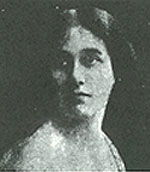 In
February 1906 Sylvia Blackston recorded Where corals
lie for HMV to release on 3638. With six other songs netted
at the same session also seeing the light of day, she must
have been a contralto of considerable accomplishment. Then
near year’s
end Carmen Hill (pictured) sang two songs with the North
Central London Orchestral Society to conclude a programme of
mainly
music by Haydn, Grieg and Brahms.
In
February 1906 Sylvia Blackston recorded Where corals
lie for HMV to release on 3638. With six other songs netted
at the same session also seeing the light of day, she must
have been a contralto of considerable accomplishment. Then
near year’s
end Carmen Hill (pictured) sang two songs with the North
Central London Orchestral Society to conclude a programme of
mainly
music by Haydn, Grieg and Brahms.
Having heard Florence Venning sing The sweetest flower
that blows via Columbia cylinder 200466 from 1903 and A
tiny seed of love on cylinder 13814 cut by Edison in 1908,
I am encouraged to think she may have utilized her lovely dark
contralto to sing Elgar’s sea cycle, but her involvement
with Gilbert and Sullivan operas as “Ada Florence” may
have meant she had little time for Elgar.
As originator, Clara Butt frequently sang Sea Pictures. She
did so with Henry Wood's Queen's Hall Orchestra on 7 January
1909 and in 1912, she wowed the Viennese with this strange
and wonderful music. For some reason, she failed to record
the complete
cycle. She did preserve three songs but in the end only two
versions of one were issued. For HMV on 24 June 1909, she recorded Sea
Slumber Song and Sabbath Morning at Sea, neither
to be released. Three years later on 24 July 1912, HMV again
recorded Sabbath
Morning at Sea and two versions of Where corals lie,
the second issued as 03299. After she joined Columbia she recorded Where
corals lie on 16 September 1920 and this was issued as
well.
Contralto Grainger Kerr sang two of Elgar’s Sea
Pictures during the final concert of famous conductor Hans
Richter at Eastbourne on 22 April 1911. The avant-gardiste
of her day, she introduced Norman O’Neill’s ballade
for contralto and orchestra, Death on the Hills at a
Proms concert on 8 September 1904 and in support of Granville
Bantock
sang his Evening Star in Nottingham in November 1906
and again on 13 January 1907. Another faintly remembered artist Marion
Beeley must have been special for she sang Erda in both Das
Rheingold and Siegfried and Siegrune in Die Walküre when
Wagner's Ring was given in Leeds late in October 1913.
During a National Sunday League concert at the London Palladium
on 28 January 1912 with Beecham leading, Marion sang Where
corals lie and The Swimmer and added Softly awakes
my heart from Saint-Saëns' Samson et Dalila. She
can be heard in Songs my mother sang by Grimshaw, My
ships by Bishop and The Call of the Homeland by
Teschemacher, all 78 rpms made by HMV. Early in 1915, Violet Oppenshaw recorded
for HMV Sabbath Morning at Sea, In haven and Where
corals lie but just the latter two were released. And when
she sang in Bournemouth on 25 October, she again chose In
haven.
Amongst other excellent English contraltos and Elgar songbirds
were Alice Lakin, Ethel Hook (a sister of Clara Butt)
and Olga Haley though none seems to have left for posterity
any of Elgar’s music. Olga was born into a musically gifted
family and studied at the Royal College of Music. She made a
stab at opera singing Carmen with the newly formed British
National Opera but found her true forte concentrating on modern
music. At a Promenade Concert in the Royal Albert Hall on 9
June 1915, she sang three songs from Bantock’s Sappho and The
shepherd’s song by Elgar. Then at Beecham’s Delius
Festival of 1929, she joined others on 16 October at the Aeolian
Hall to offer a series of Delius songs, seven in all. On 11 December
for a BBC broadcast Olga offered Part I of Bantock’s Omar
Khayyam with Parry Jones and Dennis Noble. Then on 5 March
1934 in Leeds, she joined Noble in launching Delius’s Songs
of Sunset.
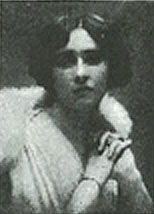 Phyllis
Lett (pictured), Elgar and the London Symphony visited
Hull on 26 October 1909 to present one of the first concerts
in the
new City Hall. After Elgar led the orchestra in his First Symphony,
which he had introduced the previous December in London, Phyllis
sang Sea Pictures, almost certainly the first to do
so in Hull. Then, after Elgar conducted his Wand of Youth
Suite No. 2, a Pomp and Circumstances March (probably
No. 1) and Tchaikovsky’s Serenade for Strings, Phyllis
added the familiar Ombra mai fu.
Phyllis
Lett (pictured), Elgar and the London Symphony visited
Hull on 26 October 1909 to present one of the first concerts
in the
new City Hall. After Elgar led the orchestra in his First Symphony,
which he had introduced the previous December in London, Phyllis
sang Sea Pictures, almost certainly the first to do
so in Hull. Then, after Elgar conducted his Wand of Youth
Suite No. 2, a Pomp and Circumstances March (probably
No. 1) and Tchaikovsky’s Serenade for Strings, Phyllis
added the familiar Ombra mai fu.
In June 1915, both Phyllis Lett and Ethel Hook appeared at
Proms Concerts. On 15 June, Phyllis sang In haven and Where
corals lie along with None will know by Landon Ronald
and The Fairy Pipers by Herbert Brewer. The next evening
Ethel sang Pour aimer d’amour by Isidore de Lara.
Phyllis again sang two of Elgar’s sea songs with Sir Henry
Wood on 21 December 1918 in Liverpool. She tackled the full cycle
on 27 February 1922 when Elgar conducted a Brand Lane Concert
in Manchester. Although Phyllis made a goodly number of 78s,
including Elgar's Ave Verum, she did not record Sea
Pictures.
Welsh contralto Leila Megane (1891-1960) was first to
record the complete cycle. With the composer conducting on
10 November 1922, Leila recorded for HMV Nos. 2 and 3 … and
the others on 8 January 1923: It is part of Pearl’s 5 CD
Elgar Edition, GEMM CDS 9951-5. Born "Maggie Jones" at
Bethesda in Caernarfonshire, Leila was assisted financially by
Prime Minister David Lloyd George and others to study in Paris
with Jean de Rezske. In June 1919, she appeared at Covent Garden
in Massenet's Thérèse and with the Opéra
Comique in Paris as Charlotte in that composer's Werther with
Leon Beyle and Charles Panzera. Her Sea Pictures, though
acoustically recorded, due in part to Elgar's participation,
serves as Leila's ticket to immortality.
When radio began to cause a stir in England, many heard Elgar's
music for the first time. Sea Pictures was first broadcast
on 20 September 1923 when an enterprising Dan Godfrey offered
it at a concert in Manchester with local contralto Rachel
Hunt as soloist. Elgar’s turn “on-air” came
during a concert he led on 31 March 1925 when Astra Desmond (1898-1973)
sang the Angel's Farewell from The Dream of Gerontius. They
followed that year with Sea Pictures on 13 November
during a relay from the Eastbourne Festival. After studying
with Blanche
Marchesi, Astra earned high acclaim singing all of Elgar’s
great mezzo/contralto roles. In fact, her musical leanings ranged
from ballad concerts to the songs of Kilpinen, Stravinsky and
Henry Purcell. In March 1930, when National and Regional programmes
were introduced Elgar’s music could be heard throughout
the British Isles. Singers were eager to sing his songs, in particular Sea
Pictures and following their initial broadcast in 1923
through February 1934, Pictures or individual songs
therefrom were heard an incredible 256 times!
One of those performers may have been contralto Mary Cartwright who
on 14 May 1929 recorded Where corals lie with the distinguished
Madame Adami as her accompanist. Unfortunately HMV did not
deem it worthy of release.
Britain’s centuries old tradition of religious music is
celebrated annually at the Three Choirs Festival, in rotation
between the cathedrals at Hereford, Worcester and Gloucester.
Ever since Elgar had provided his Overture Froissart for
the 1890 Festival and The Light of Life in 1896, his
music had become regular festive fare. In 1902 Marie Brema
was engaged
for The Dream of Gerontius at Worcester on 11 September
but when she fell ill, Muriel Foster sang. At the secular concert
that followed Muriel sang Sea Pictures Nos. 2, 4 and
5. It
wasn’t until 1911 that the remaining pair, Sea slumber
song and Sabbath morning at sea were heard at a
Festival when Muriel Foster sang them at Worcester.
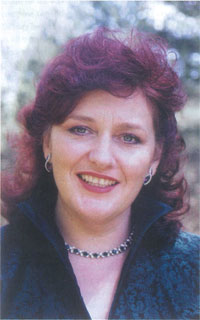 Oddly enough, this was the last time Festival organizers scheduled
any of the songs until 1983 when the full cycle was given at
Gloucester. Eight years later they surfaced at Hereford. Then,
after a performance at Gloucester in 2001, Paul Bassett wrote
in The Elgar News: "The jewel in the crown turned out to
be Sea Pictures in the final evening with, once again,
the Philharmonic Orchestra, this time under David Briggs. Catherine
Wyn-Rogers (pictured) was the soloist, and singing without
a score, gave one of the most beautiful and moving performances
of Sea
Pictures it has been my privilege to hear. This was not
a clinical performance as sometimes is the case, but an emotional,
compelling and intense one, with the audience spellbound by
Miss
Wyn-Rogers’ tour-de-force as she held centre-stage in a
stunning midnight sequined dress. The range from the peaceful
`Sea Slumber Song' to the surging and powerful `The
Swimmer' was beautifully portrayed and the audience quite
rightly called Miss Wyn-Rogers back for five curtain calls." As "the
leading female exponent of Elgar's choral works”, she sang
the work at a Royal Albert Hall Proms with Sir Andrew Davis on
the podium and HM The Queen in attendance. It was broadcast and
subsequently released on CD (BBC/Warner 2564 61550-2) together
with items by Walton, Britten and Bax from the same concert.
Oddly enough, this was the last time Festival organizers scheduled
any of the songs until 1983 when the full cycle was given at
Gloucester. Eight years later they surfaced at Hereford. Then,
after a performance at Gloucester in 2001, Paul Bassett wrote
in The Elgar News: "The jewel in the crown turned out to
be Sea Pictures in the final evening with, once again,
the Philharmonic Orchestra, this time under David Briggs. Catherine
Wyn-Rogers (pictured) was the soloist, and singing without
a score, gave one of the most beautiful and moving performances
of Sea
Pictures it has been my privilege to hear. This was not
a clinical performance as sometimes is the case, but an emotional,
compelling and intense one, with the audience spellbound by
Miss
Wyn-Rogers’ tour-de-force as she held centre-stage in a
stunning midnight sequined dress. The range from the peaceful
`Sea Slumber Song' to the surging and powerful `The
Swimmer' was beautifully portrayed and the audience quite
rightly called Miss Wyn-Rogers back for five curtain calls." As "the
leading female exponent of Elgar's choral works”, she sang
the work at a Royal Albert Hall Proms with Sir Andrew Davis on
the podium and HM The Queen in attendance. It was broadcast and
subsequently released on CD (BBC/Warner 2564 61550-2) together
with items by Walton, Britten and Bax from the same concert.
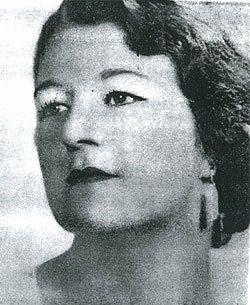 The
long-running Promenade Concerts showed little interest from
1951 to 1960, offering three songs on two occasions and
two at
another concert. Lewis Foreman reporting in BMS News 112 did
not identify the singers or the songs. A recording of the full
cycle made in 1926 by Muriel Brunskill (1899-1980, pictured)
is available on Elgar Interpreters CD Volume 2, CDAX
8020. She featured the music often in concerts. In Southport
on 14
February 1927, she sang Where corals lie and The
Swimmer as
well as songs by Moussorgsky, Grechaninov, Rachmaninov and
Quilter. Then on 2 June that year to celebrate Elgar's birthday,
she sang Sea
Pictures together with other music by the composer. A pupil
of Blanche Marchesi, Muriel had a remarkable voice with an
ability to adjust to whatever she sang, be it opera, oratorio,
lieder,
musicals, films or Gilbert and Sullivan. “Unforgettable” was
Isobel Baillie’s reaction to her Delilah in Manchester
at a concert version of Aida on 17 November 1922 with
the Leeds Choral Union; she sang Amneris "with magnificence
of tone and style". Muriel also sang in Beecham's first
recording of Messiah and while singing this work with
the Bradford Old Choral Society, she "stood out for general
excellence" being regarded as "now in the first rank
of British contralto singers". During a concert in Bournemouth
on 13 August 1933, she again sang Where corals lie.
The
long-running Promenade Concerts showed little interest from
1951 to 1960, offering three songs on two occasions and
two at
another concert. Lewis Foreman reporting in BMS News 112 did
not identify the singers or the songs. A recording of the full
cycle made in 1926 by Muriel Brunskill (1899-1980, pictured)
is available on Elgar Interpreters CD Volume 2, CDAX
8020. She featured the music often in concerts. In Southport
on 14
February 1927, she sang Where corals lie and The
Swimmer as
well as songs by Moussorgsky, Grechaninov, Rachmaninov and
Quilter. Then on 2 June that year to celebrate Elgar's birthday,
she sang Sea
Pictures together with other music by the composer. A pupil
of Blanche Marchesi, Muriel had a remarkable voice with an
ability to adjust to whatever she sang, be it opera, oratorio,
lieder,
musicals, films or Gilbert and Sullivan. “Unforgettable” was
Isobel Baillie’s reaction to her Delilah in Manchester
at a concert version of Aida on 17 November 1922 with
the Leeds Choral Union; she sang Amneris "with magnificence
of tone and style". Muriel also sang in Beecham's first
recording of Messiah and while singing this work with
the Bradford Old Choral Society, she "stood out for general
excellence" being regarded as "now in the first rank
of British contralto singers". During a concert in Bournemouth
on 13 August 1933, she again sang Where corals lie.
Petite Margaret Balfour was a remarkable contralto often
heard in Messiah, once earning this accolade: "her
contralto voice has a rich and resonant timbre that impresses
... she is a true artiste, and for passionate music it would
be almost impossible to find her equal ..." Beecham conducted
as she sang the sea cycle minus On Sabbath Morning at
the Town Hall in Leeds on the opening day of that city's Triennial
Festival early in October 1928. For Columbia she recorded In
haven and Where corals lie and is prominent in excerpts
of Dream of Gerontius recorded in 1927 with Elgar conducting.
For a broadcast in 1933, Madame Balfour sang Sea Pictures at
a Proms Concert that included Albert Sammons playing Elgar's
Violin Concerto. Rispah Goodacre (1897-1971) also sang
two sea songs in 1933 at a concert from Belfast on 14 October
conducted by E. Godfrey Brown replacing a suddenly ill Elgar.
The splendid British contralto Mary Jarred (1899-1995)
spent years at the Hamburg Opera where she developed a keen
interest in modern music, Pfitzner, Alban Berg and the like
but all that
ended in the mid-1930s when she fled the Nazis to return to
England. She featured the full cycle in a concert on 20 June
1937 with
a BBC Orchestra conducted by Clarence Raybould. From this broadcast,
the Elgar Society has released on CD Sea Slumber Song,
most of Sabbath Morning at Sea and part of The Swimmer.
The latter was included on October 1937 when Enid Cruikshank appeared
on a BBC programme.
Between the two versions of Where corals lie by Clara
Butt and Janet Baker’s recording, one would think that
legendary Kathleen Ferrier would have been an ideal
interpreter. However she got off to a rocky start in 1944 in
Sheffield when
under Barbirolli’s direction, she sang Sea Pictures for
the first time. On 16 December 1946 she wrote to her agent, “I
don’t think I’m a very good Sea Pictures-ite
and have been wondering if for Brighton -10 May - they would
let me off with the middle three - In Haven, Sabbath Morning and Where
Corals Lie and let me push in something else in which I’m
happier”. She may have felt that some of the music lay
too high for her or perhaps the words in the other songs did
not please her. Of Elgar’s music, Kathleen did leave My
work is done and It is because, tantalizing excerpts
from The Dream of Gerontius.
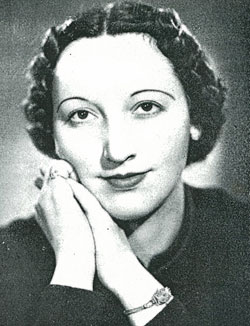 The
vivacious and fun-loving nature of Gladys Ripley (1908-1955,
pictured) recorded Sea Pictures twice in 1946 for HMV
and in 1954 for Columbia, a year before her untimely death
at age
47. The
later recording is part of a CD (SOMMCD 073) that pays tribute
to its conductor George Weldon. After debuting in London in Elijah at
age 17, Gladys appeared occasionally in opera but it was mainly
oratorio that kept her busy. In 1940 she accompanied Isobel
Baillie and Heddle Nash on an operatic tour of New Zealand
to take the roles of Carmen and Marthe in Faust with
naturally many Messiahs, Creations and Elijahs.
In 1945 for Columbia she sang the Angel in Sir Malcolm Sargent’s
famed recording of The Dream of Gerontius, then in his
recordings of Messiah the following year and Elijah in
1947. In her book Isobel Baillie claims she sang Where Corals
Lie in
concert.
The
vivacious and fun-loving nature of Gladys Ripley (1908-1955,
pictured) recorded Sea Pictures twice in 1946 for HMV
and in 1954 for Columbia, a year before her untimely death
at age
47. The
later recording is part of a CD (SOMMCD 073) that pays tribute
to its conductor George Weldon. After debuting in London in Elijah at
age 17, Gladys appeared occasionally in opera but it was mainly
oratorio that kept her busy. In 1940 she accompanied Isobel
Baillie and Heddle Nash on an operatic tour of New Zealand
to take the roles of Carmen and Marthe in Faust with
naturally many Messiahs, Creations and Elijahs.
In 1945 for Columbia she sang the Angel in Sir Malcolm Sargent’s
famed recording of The Dream of Gerontius, then in his
recordings of Messiah the following year and Elijah in
1947. In her book Isobel Baillie claims she sang Where Corals
Lie in
concert.
Prior to and just after World War II, Elgar's Sea Pictures faded
despite the efforts of low-voiced ladies such as Janet Howe, Betty
Bannerman and Nancy Evans, all Elgar interpreters. Edith
Furmedge (1898-1956) who studied with Algerian baritone
Dinh Gilly later became his wife. She was the Angel in the
1924 acoustic
recording of The Dream of Gerontius. Following studies
with John McCormack’s teacher Victor Beigel, contralto Constance
Shacklock, a favourite at the Royal Opera prior to and
following World War II, sang Sea Pictures in 1957 at
a concert that fortunately was recorded. Born in 1913, she
is lovingly remembered
by Prommers for her rousing Rule Britannia on the final
night.
On 29 May 1951 at a Henry Wood concert in Albert Hall, Sir
Malcolm Sargent directed the London Symphony Orchestra in a
programme
that celebrated 20 years of Elgar's music with Sea Pictures a
lively opening. The soloist, Kathleen Joyce, displayed
a pleasant contralto voice that, lighter than the type Elgar
envisaged, also lacked the temperament, the wide variety of
tone-colour and the dynamics needed to express the various
mood changes. Patricia
Kern did better with a broadcast of Where corals lie and
lieder by Brahms on 21 July 1967.
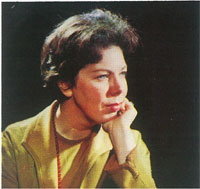 Late
in 1964 when EMI decided to record The Dream of Gerontius,
Sir John Barbirolli’s long association with Elgar’s
music ensured that he became the conductor for Janet
Baker (pictured), Richard
Lewis and Kim Borg. In a conversation with Andrew Greene on
BBC in 1999, Dame Janet recalled how she was not keen initially
about Sea
Pictures; however she gave in to the entreaties of Sir
John when EMI announced plans to record it. “I was absolutely
swept up in his enthusiasm and love for the piece and his tenderness
- the way he makes a very difficult song cycle possible for
the voice - suddenly made me see it in a different light. I
did grow
to love it, with reservations about the last song, which I
find is horrendously difficult and very unsatisfying from the
poetry
point of view, putting the words over.” The recording
from August 1965 remains a beloved classic in current catalogues.
Late
in 1964 when EMI decided to record The Dream of Gerontius,
Sir John Barbirolli’s long association with Elgar’s
music ensured that he became the conductor for Janet
Baker (pictured), Richard
Lewis and Kim Borg. In a conversation with Andrew Greene on
BBC in 1999, Dame Janet recalled how she was not keen initially
about Sea
Pictures; however she gave in to the entreaties of Sir
John when EMI announced plans to record it. “I was absolutely
swept up in his enthusiasm and love for the piece and his tenderness
- the way he makes a very difficult song cycle possible for
the voice - suddenly made me see it in a different light. I
did grow
to love it, with reservations about the last song, which I
find is horrendously difficult and very unsatisfying from the
poetry
point of view, putting the words over.” The recording
from August 1965 remains a beloved classic in current catalogues.
When Janet Baker sang the cycle three years later in New Zealand,
she could not have been more exciting to this writer’s
ears as by now she could do no wrong with the music. She sang
the cycle at a St. Cecilia's Day Concert with The Royal Philharmonic
Orchestra conducted by Lorin Maazel, causing the Duke and Duchess
of Kent to join those screaming and shouting in ecstasy at its
conclusion. She sang Sea Pictures at the Royal Festival
Hall on 18 December 1975 with Maazel and on 6 February 1979,
replacing an indisposed Alfreda Hodgson with Davis and the
Philharmonia and at a Proms Concert on 9 September 1982 at
the Royal Albert
Hall with James Loughran as conductor. It is on a Carlton Classics
CD.
When Sir John Barbirolli stepped onto the podium at King's
Lynn on 24 July 1970 to conduct Sea Pictures, he was
a very sick man, and with singer Kerstin Meyer uneasy
at times with the words, they produced a sluggish, ponderous
performance.
Sadly it was the conductor’s last as he died a few days
later. Swedish-born Miss Meyer made her debut in 1952 in her
home city of Stockholm as Azucena in Il Trovatore, then
went on to fashion a major international career. Another Swede, Birgit
Finnila recorded Sea Pictures in 1976 for BIS Records
with piano accompaniment by Geoffrey Parsons. Then there’s Birgitta
Svendén’s dark and beautiful voice in the version
on Forlane, conducted by Mackerras. Carrying on the northern
tradition, Anne Sofie Von Otter on 4 June 1999 gave
a well-reasoned performance at Worcester Cathedral with Richard
Hickox and the Philharmonia Orchestra.
Australia has produced its share of skilled Sea Pictures performers. Clara
Serena was fond of Elgar’s music but no instance of
her singing Sea Pictures has surfaced. In Sydney mezzo Elizabeth
Connell sang three sea songs in June 1975 while two years
later, the brilliant Yvonne Minton left her mark, recording
the cycle for CBS Records under Daniel Barenboim's direction,
her lovely, creamy sound making this version very special indeed.
Meanwhile another mezzo, Heather Begg, sang Sea Pictures along
with arias from Alceste and Alcina at the Auckland
Town Hall on 22 October 1981 during a concert with the Auckland
Symphony under Jack Spiers. The Gluck was broadcast;
Elgar’s
music was not. Lauris Elms had better success committing
her version to disc. A recording of a complete Sea Pictures on
ABC Classics CD (476 7966) features Australian mezzo Elizabeth
Campbell with the Adelaide Symphony Orchestra conducted
by Nicholas Braithwaite. In reviewing this performance in the
March
2006 Elgar Journal, Andrew Neill noted redeeming qualities
but felt “her tone seems, at times, to vary from line to line
in the five songs. This means that this is not a relaxing listen.”
As for Canadian involvement, Maureen Forrester recorded Sea
Pictures for the CBC as I discovered while driving about
Winnipeg one frosty night. It stayed in my mind for months.
Maureen sprang to prominence in Toronto in 1961 in Gluck's Orfeo ed
Euridice and quickly became one of Canada's greatest international
stars. She appeared on television in such works as The Medium by
Menotti and very often in concerts across the country. Another
Canuck, Linda Maguire, made a valiant effort with the
Winnipeg Symphony, Bramwell Tovey conducting, but her singing
pales beside the outpourings of Janet Baker. We are left to
ponder if another great Canadian mezzo Judith Forst ever
sang the music.
Legendary American mezzo Marilyn Horne offered the sea
songs during an Elgar Concert Zubin Mehta gave with the New
York Philharmonic orchestra on 6 January 1980. Listening to
a tape
of the broadcast, we hear Miss Horne plunge ahead, her voice
acquiring a slight tremolo and pouring forth with little nuance,
but what majesty! Lili Chookasian, a Chicago native
of Armenian descent, often likened to the deep contraltos of
old,
supplied proof when she sang Sea Pictures in Cleveland
with the Symphony Orchestra conducted by Robert Paige. A pupil
of Rosa Ponselle, Lili made her Metropolitan Opera debut on
9 March 1962 as La Cieca in La Gioconda with Zinka Milanov,
Franco Corelli and Robert Merrill. Subsequently she added Mamma
Lucia, Ulrica and Madelon. Away from the Met, her performances
included Prokofiev’s Alexander Nevsky with the
New York Philharmonic. Also in Ohio but in Springfield, contralto D'Anna
Fortunato presented her Sea Pictures on 18 January
1982 to appreciative listeners. In Philadelphia on 16 March
2006, contralto Meredith Erwady sang Sea Pictures accompanied
by Mikael Eliasen, doing so with intelligence and considerable
power when needed. Miss Erwady, who was trained at the Curtis
Institute, sang with the Chicago Lyric Opera and was a Metropolitan
Opera Auditions winner in 2004.
An audience in Minneapolis was treated to the cycle on 24 September
1985 when English contralto Carolyn Watkinson sang with
the Minnesota Orchestra, an event that radio listeners could
also enjoy. Born in Preston, Lancashire, Ms Watkinson studied
at the Royal College of Music and in Amsterdam where she took
up residence. In 1981, she successfully debuted at La Scala
as Ariodante in
a production that was repeated the following year and then
at Glyndebourne. Earlier, she sang Sea Pictures over
Netherlands Radio on 20 September 1978.
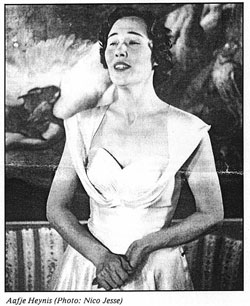 Famed Dutch mezzo Tilly Koenen sang a few of Elgar’s
sea songs in Ostend, Belgium when the composer visited to conduct
his music at the 1906 Festival. Then an historic recording Maartje
Offers made of Where corals lie on 15 April 1929
with John Barbirolli was issued on HMV DB 1761 but her Sabbath
Morning at Sea recorded at the same session was a non-issue.
Though she toiled with certain English words, Klein complemented
her for “her superb organ and chaste artistic style (that)
place her among the leading contraltos of the present time”.
A rather ponderous lady with a wide vocal range and more a dramatic
soprano than contralto, she died on 28 January 1944. Dutch audiences
had their fondness for Elgar especially his Sea Pictures reinforced
when Kathleen Ferrier sang there in the fifties. When Netherlands
Radio decided to broadcast ’Where corals lie’ on
10 March 1962, Aafje Heynis (pictured), a renowned Mahler specialist
was the chosen soloist. It is reported that over 200 of her
recordings, some dating back to the 1950s, lie buried in Netherlands
Radio
archives. In the 1970s both Ms. Heynis and Elly Jens sang
all or part of Sea Pictures on air. Madame Jens, confined
to a wheel-chair, sang for NCVR (Dutch) radio but in the 1990s,
when the station planned a re-broadcast and found they had
problems with their tape they requested the loan of Elly’s tape.
She was happy to oblige but never saw it again. She died in November
1998. On 18 June 1983 Jard Van Nes sang Elgar’s
piano arrangement of Sea Pictures with Gérard van
Blerk as pianist in the Muziekcentrum, Vredenberg at Utrecht
during a Holland Festival. All Europe heard her sea cycle plus
seven other Elgar songs in stereo.
Famed Dutch mezzo Tilly Koenen sang a few of Elgar’s
sea songs in Ostend, Belgium when the composer visited to conduct
his music at the 1906 Festival. Then an historic recording Maartje
Offers made of Where corals lie on 15 April 1929
with John Barbirolli was issued on HMV DB 1761 but her Sabbath
Morning at Sea recorded at the same session was a non-issue.
Though she toiled with certain English words, Klein complemented
her for “her superb organ and chaste artistic style (that)
place her among the leading contraltos of the present time”.
A rather ponderous lady with a wide vocal range and more a dramatic
soprano than contralto, she died on 28 January 1944. Dutch audiences
had their fondness for Elgar especially his Sea Pictures reinforced
when Kathleen Ferrier sang there in the fifties. When Netherlands
Radio decided to broadcast ’Where corals lie’ on
10 March 1962, Aafje Heynis (pictured), a renowned Mahler specialist
was the chosen soloist. It is reported that over 200 of her
recordings, some dating back to the 1950s, lie buried in Netherlands
Radio
archives. In the 1970s both Ms. Heynis and Elly Jens sang
all or part of Sea Pictures on air. Madame Jens, confined
to a wheel-chair, sang for NCVR (Dutch) radio but in the 1990s,
when the station planned a re-broadcast and found they had
problems with their tape they requested the loan of Elly’s tape.
She was happy to oblige but never saw it again. She died in November
1998. On 18 June 1983 Jard Van Nes sang Elgar’s
piano arrangement of Sea Pictures with Gérard van
Blerk as pianist in the Muziekcentrum, Vredenberg at Utrecht
during a Holland Festival. All Europe heard her sea cycle plus
seven other Elgar songs in stereo.
Surely a most unique performance occurred in the Grand Hall
of the Moscow State Conservatoire on 11 April 1977 when Larisa
Avdeyeva sang Sea Pictures with the late Evgeny
Svetlanov conducting. The familiar words sung in Russian create
an odd
and eerie sound but one that definitely grows on a western
listener. It was recorded by Melodiya and re-released in 2003
on CD (Scribendum
SC 032). In the July 2004 Journal, Barry Collett pointed out
that “the Moscow audience liked it because we have an encore
of Where corals lie”.
When Elgar's cycle was given in Hull by the Choral Union in
1971 it was in a sea setting, consisting of paintings, models,
equipment,
lamps, uniformed cadets and a piping party of ratings, the
artists being Norma Procter and Benjamin Luxon with
the Capriol Orchestra of London. The programme included the
well known and
often nostalgic music of Elgar's Sea Pictures, Stanford's Songs
of the Sea, Henry Wood's arrangement of Fantasia on Sea
Songs and Mendelssohn's Hebrides Overture. "Miss
Procter sang with complete assurance and illuminating sincerity." Obviously
she was a favourite in Hull as she re-appeared fourteen times
over twenty-five years, mostly in Messiah.
According to the late basso Dennis Wicks, his famed colleague
mezzo Josephine Veasey considered parts of the music
too low so she did not sing Sea Pictures. However when
Welsh mezzo Helen Watts came to Winnipeg for a recital
on 6 November 1972, I asked her if she ever sang Elgar’s cycle. "Oh
Yes!" she exclaimed enthusiastically, "Many
times. It's a lovely work I enjoy singing very much." Not
long after via tape, I did hear her sing this music with the
Welsh Orchestra conducted by Owain Arwel Hughes over the BBC
on 21 January 1974. Then consider Marjorie Thomas who
sang The Dream of Gerontius and presumably she tackled
the sea cycle too. Mezzo Gillian Knight was splendid
on Saturday, 16 September 1976, with Sir Charles Groves leading
the BBC Symphony Orchestra for a Proms audience and others
tuned
in to the BBC. A recording of Elgar’s cycle Irish mezzo Bernadette
Greevy made for EMI in 1981 with the London Philharmonic
Orchestra later appeared on CD. Bernadette offers a beautiful
performance, perfectly paced by conductor Vernon Handley. Also
for EMI, Felicity Palmer recorded the cycle in 1987
with Richard Hickox and the London Symphony. Especially to
be relished
is her opening Slumber Song. This Sea Pictures is
coupled with a rousing rendition of The Music Makers,
Op. 69.
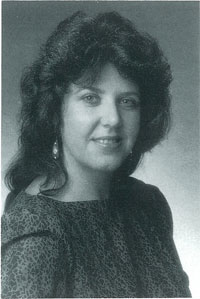 Another
worthy interpreter keeping the music alive is Della
Jones, a Welsh mezzo from Neath. She studied at the Royal
College of Music before carving out a nice niche for herself
in international opera. She sang Elgar’s cycle frequently
with the BBC National Orchestra of Wales ranging from Aberystwyth
on 2 May 1985 to St. David’s Hall in 1994 and beyond,
while recording the work for Decca. Anne Collins offered
an Elgar programme on BBC in August 1983 that omitted Sea
Pictures but
surely she sang the full cycle at other times. It is said that,
when Jean Rigby sings Sea Pictures she sounds
uncannily like Janet Baker although fans of Catherine Wyn-Rogers
make the
same claim. In April 1991 for a Chandos CD released a year
later, contralto Linda Finnie (pictured) recorded Sea
Pictures with
The London Philharmonic Choir and Orchestra, Bryden Thomson
as conductor. Though beautifully sung, it remains a placid
studio
version. Others tackling the music at various British venues
at this time were Sara Fulgoni and Fiona Kimm.
Another
worthy interpreter keeping the music alive is Della
Jones, a Welsh mezzo from Neath. She studied at the Royal
College of Music before carving out a nice niche for herself
in international opera. She sang Elgar’s cycle frequently
with the BBC National Orchestra of Wales ranging from Aberystwyth
on 2 May 1985 to St. David’s Hall in 1994 and beyond,
while recording the work for Decca. Anne Collins offered
an Elgar programme on BBC in August 1983 that omitted Sea
Pictures but
surely she sang the full cycle at other times. It is said that,
when Jean Rigby sings Sea Pictures she sounds
uncannily like Janet Baker although fans of Catherine Wyn-Rogers
make the
same claim. In April 1991 for a Chandos CD released a year
later, contralto Linda Finnie (pictured) recorded Sea
Pictures with
The London Philharmonic Choir and Orchestra, Bryden Thomson
as conductor. Though beautifully sung, it remains a placid
studio
version. Others tackling the music at various British venues
at this time were Sara Fulgoni and Fiona Kimm.
In this century, mezzo-soprano Louise Winter sang Sea
Pictures at an all-Elgar Concert at Bridgewater Hall in
Manchester on both 12 and 14 June 2002 with Sir Charles Mackerras
conducting.
Another version by Sarah Connolly recorded in January
2006 has appeared on a Naxos CD. Emerging from County Durham
to study at the Royal College of Music, she has fashioned an
international career leading in 2005 to an appearance at the
Metropolitan Opera in New York as Annio in Mozart’s La
Clemenza di Tito. Her Sea Pictures is especially
moving, highlighted by her precise diction and truly lovely
voice. Simon
Wright leads the Bournemouth Symphony Orchestra and Chorus
as well in Elgar’s The Music Makers. An even more
recent recording features Claire-Louise Lucas in the
alternative version with husband Jonathan Darnborough at the
piano. On her
CD for Claudio, she also sings four other Elgar songs and two
by Vaughan Williams. “Dates for your Diary” in every
issue of The Elgar News, lists upcoming Sea Pictures performances
and though the soloist is not always identified, this encourages
a belief that the music having flourished for more than a century
is on its way to immortality.
While purists may consider this music less than Elgar's finest,
it did emerge between Enigma Variations and Gerontius and
it certainly works for most of us. For its happy estate, we
can look back with gratitude on performances by Dame Janet
Baker
that have led us to a full appreciation. So, on behalf of all
lovers of this music, Dame Janet, many thanks!
With apologies to the legions of singers of the past and those
of today who still perform Sea Pictures and yet were
overlooked in this report.
Acknowledgements
Thanks to Andrew Neill for providing information about
early broadcasts of Sea Pictures in England. The late Jim McPherson
helped by supplying data about Muriel Foster’s time in North America as did Roger
Beaumont for activity in New Zealand. I am also grateful to André Achtien
in The Hague for insights concerning Dutch artists, to Paul Campion in London
for reporting on Kathleen Ferrier’s views towards this music and to Wayne
Turner in the UK for information concerning other British artists.
Other Sources
Sir Thomas Beecham, Bart, C.H., A Calendar of his Concert and Theatrical performances
compiled by Maurice Parker, 1985 & Supplement by Tony Benson.
“Clara Butt: Her life Story” by Winifred Ponder, George G. Harrop & Co.
Ltd, London, 1928
“Elgar and the Three Choirs Festival” by Donald Hunt, Osborne Books
Limited, St. John’s, Worcester, 1999
“
Two Centuries of Music in Hull” by Norman Staveley, Hutton Press, 1999
“Elgar in Smyrna, 1905” by Andrew Neill, The Elgar Journal, November
2005
“
Music in England 1885-1920” by Lewis Foreman, Thames Publishing 1994
“
Never sing louder than lovely” by Isobel Baillie, Hutchinson & Co,
1982
Discography of Barbirolli’s Elgar Recordings by K. D. Mitchell, Elgar Journal,
Vol. 12, No. 1, March 2001
“
Bournemouth, a Microcosm of Musical England” by Stephen Lloyd in “Oh!
My Horses” Edited by Lewis Foreman, Elgar Editions, 2000
CD liner notes by Andrew Burns for the Sarah Connolly CD, Naxos 8.557710